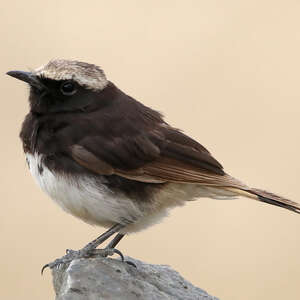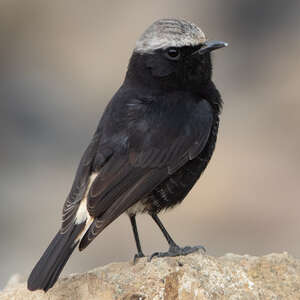Abyssinian Wheatear
Oenanthe lugubris - Traquet de Schalow Traquet de Shalow
Identification
In the Abyssinian Wheatear, the males of the nominate subspecies Oenanthe lugubris lugubris present a color polymorphism, they can consequently be confused with the females, for the two other subspecies there is however a sexual dimorphism which makes it possible to differentiate the two sexes. The male is dark brown on the upper parts. The sides of the neck, the lores, the cheeks, the chin and the throat are black but extending variably towards the chest and the sides. The forehead, the crown and the nape are brownish stained with black. The abdomen plumage is dimorphic, either white and mottled at the junction of the chest, or entirely black. The rump and the undertail-coverts are orange-buff, the bases of the rectrices are also, but more intensely. The rest of the tail is black. The female is mostly grayish brown on the upper parts, including the crown. The chin is grayish buff and the throat and the chest are somewhat darker and strongly streaked with dark brown to the limit of the abdomen and on the flanks. The abdomen, the undertail-coverts and the tail have the same characteristics as the male. The juvenile is mainly dark, lightly spotted with buff while already having the rump and the rectrices of the adults. In both sexes, the bill and the legs are black and the iris brown. The Abyssinian Wheatear comprises three subspecies: Oenanthe lugubris vauriei is confined to a small area in the mountains of northern Somalia, Oenanthe lugubris lugubris is widespread across the mountainous terrain of central Eritrea and Ethiopia, with some observations from an area in the far northwest of Kenya (where its status is yet to be established) and Oenanthe lugubris schalowi around the Rift Valley in southern Kenya and in the extreme north of Tanzania.
Subspecific information 3 subspecies
- Oenanthe lugubris lugubris (Eritrea to c Ethiopia)
- Oenanthe lugubris vauriei (ne Somalia)
- Oenanthe lugubris schalowi (s Kenya and ne Tanzania)
Foreign names
- Traquet de Schalow,
- Collalba de Shalow,
- chasco-da-abissínia,
- Abessiniensteinschmätzer,
- Rüppells Tapuit,
- Monachella d'Abissinia,
- etiopisk stenskvätta,
- Sotsteinskvett,
- skaliarik smútočný,
- bělořit etiopský,
- Etiopisk Stenpikker,
- etiopiansurutasku,
- białorzytka etiopska,
- Эфиопская каменка,
- チャガシラサバクヒタキ,
- 东非悲䳭,
- etiopienstenskvätta,
- 夏洛氏悲聲鵖,
Voice song and call
Habitat
The Abyssinian Wheatear is typically found in mountainous areas with rock-scattered habitats, on sloping and somewhat rough terrain, but also in largely could areas covered with shrubs, and some areas of scrubland and their dry riverbeds. In Ethiopia, it also favours heathlands and ploughed fields, and does not hesitate to enter villages in Eritrea. In the Rift Valley, to the south of the species' distribution, 85% of its range is in a dry, semi-arid subhumid zone.
Behaviour character trait
The Abyssinian Wheatear is largely sedentary and as a result it defends its territory throughout the year with more vigour during the breeding season. It can be seen alone or in small family groups during nesting. It is often seen perched on the edge of vegetation in order to keep an eye on its nearby environment, at the top of thorny bushes and dead shrubs or at the edge of rocky cliffs. The young birds having left the nest are often observed hiding on the ground among tufts of grass.
Dietfeeding habits
Reproduction nesting
The reproduction of the Abyssinian Wheatear has been little studied. Today, we only have a few data from the subspecies schalowi. The Abyssinian Wheatear can establish its nest as deep as 15 to 20 cm in the bottom of a rocky crevice, in the small recess of a rock, a stone wall, or a rocky cornice, in a gravel bank or on the slope of a dry river. The nest is a cup-shaped structure made of rootlets andgrass, lined with thin roots, sometimes with hairs and locks. The amount of material seems to vary according to the site. A nest built in a long tunnel will contain very little material but the entrance will be reduced or even partially closed with pieces of wood and twigs.
On the contrary, a nest built in a hollow will be more loaded with vegetation. The female lays between 2 and 3 eggs and alone incubates them for a period of 13 to 14 days. The eggs are slightly glossy, pale gray-blue to bluish-green, duller, with fine red-brown to purple spots covering the entire surface. The young are fed for about fifteen days by the male and female of the pair, sometimes with other adults. It is noted that the males of the first clutch remain in the family group and participate in the feeding of the young of the second clutch. On the other hand, the young females leave the natal territory shortly after flight. Breeding occurs throughout the year depending on the distribution area. It is from March to August in Ethiopia and from October to July in Kenya, with a possible peak in March. The period is quite unknown for northern Somalia but broods have been recorded in April, in which young were still dependent in late May.Geographic range
The Abyssinian Wheatear is endemic to East Africa, where it is found in three disjoint regions: a relatively small area in central-north Somalia where it is confined between 1,800 and 2,100 meters; a second in the highlands of Eritrea between 1,200 to 2,500 meters north and in the center of Ethiopia where its widely higher altitude presence is between 810 and 3,000 meters; finally the last distribution zone is in the center and south of Kenya and north of Tanzania between 1,200 and 3,000 meters. The species is largely resident in its distribution areas and probably largely sedentary, so there are no large migratory movements apart from some insignificant records of subspecies leaving their distribution area.
Threats - protection
Sources of information
- IOC World Bird List (v15.1), Gill, F and D Donsker (Eds). 2025-12-07.
- Birds of East Africa: Kenya, Tanzania, Uganda, Rwanda, Burundi, Terry Stevenson, John Fanshawe
- Birds of the Horn of Africa, Nigel Redman
- Birds of the World, The Cornell Lab of Ornithology
- eBird, Cornell Lab of Ornithology et National Audubon Society
Other sources of interest
 Specification sheet created on
18/07/2023 by Nathalie Santa Maria
Specification sheet created on
18/07/2023 by Nathalie Santa MariaTranslation by AI Oiseaux.net
© 1996-2025 Oiseaux.net
- Accipitriformes
- Aegotheliformes
- Anseriformes
- Apodiformes
- Apterygiformes
- Bucerotiformes
- Caprimulgiformes
- Cariamiformes
- Casuariiformes
- Charadriiformes
- Ciconiiformes
- Coliiformes
- Columbiformes
- Coraciiformes
- Cuculiformes
- Eurypygiformes
- Falconiformes
- Galliformes
- Gaviiformes
- Gruiformes
- Leptosomiformes
- Mesitornithiformes
- Musophagiformes
- Nyctibiiformes
- Opisthocomiformes
- Otidiformes
- Passeriformes
- Pelecaniformes
- Phaethontiformes
- Phoenicopteriformes
- Piciformes
- Podargiformes
- Podicipediformes
- Procellariiformes
- Psittaciformes
- Pterocliformes
- Rheiformes
- Sphenisciformes
- Steatornithiformes
- Strigiformes
- Struthioniformes
- Suliformes
- Tinamiformes
- Trogoniformes




























